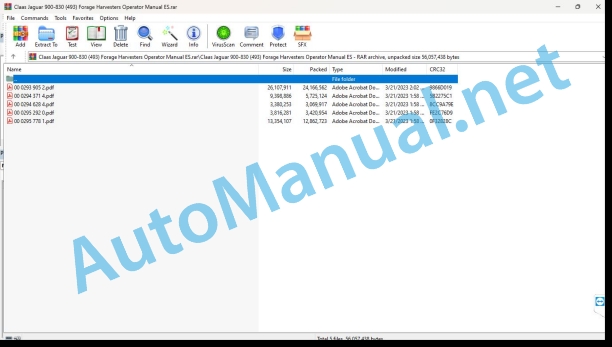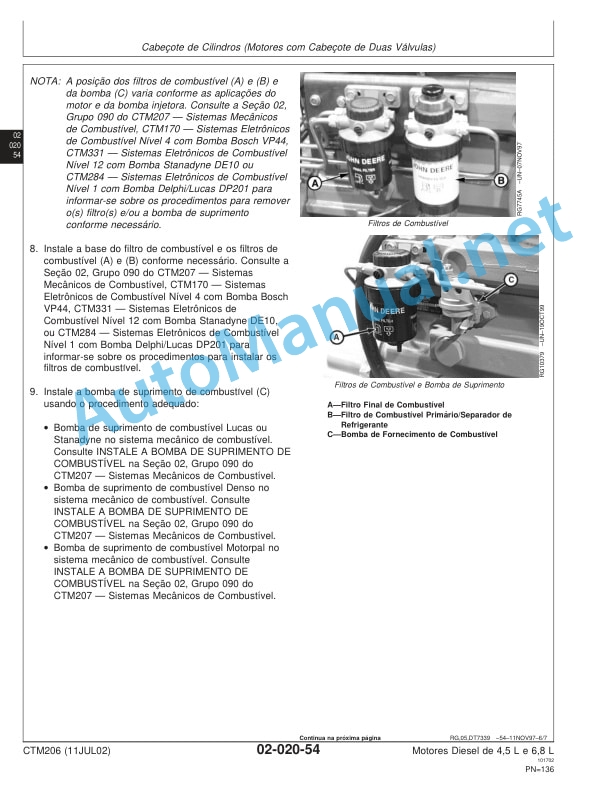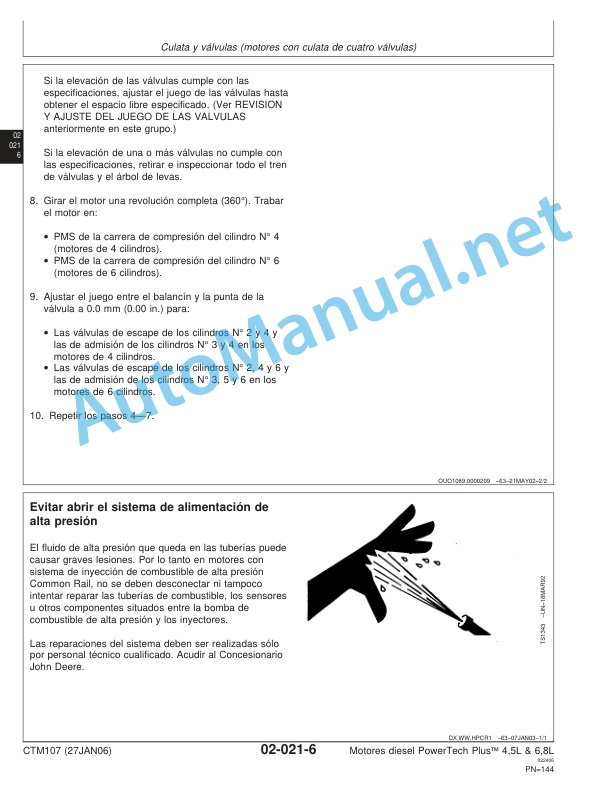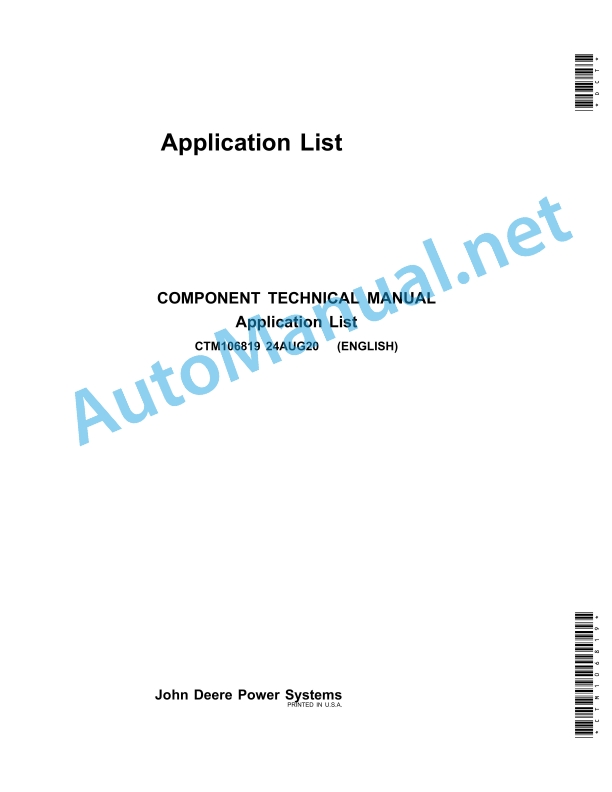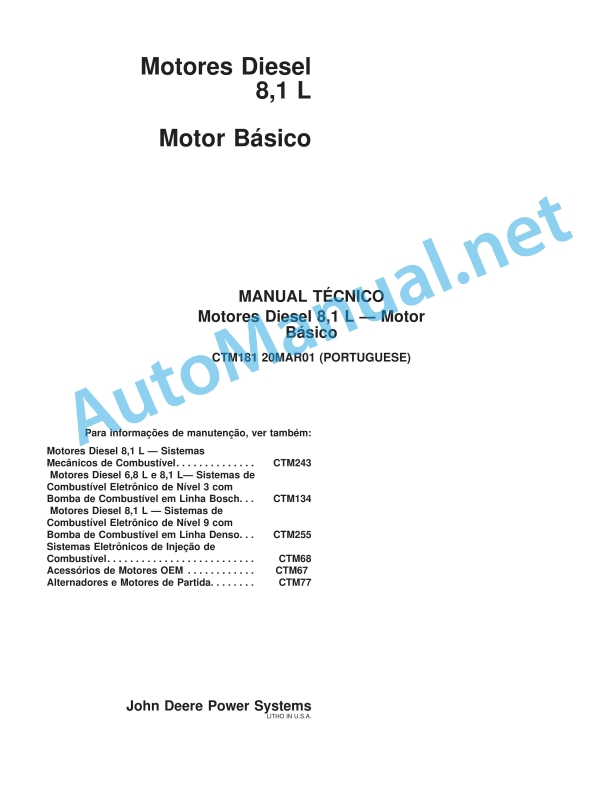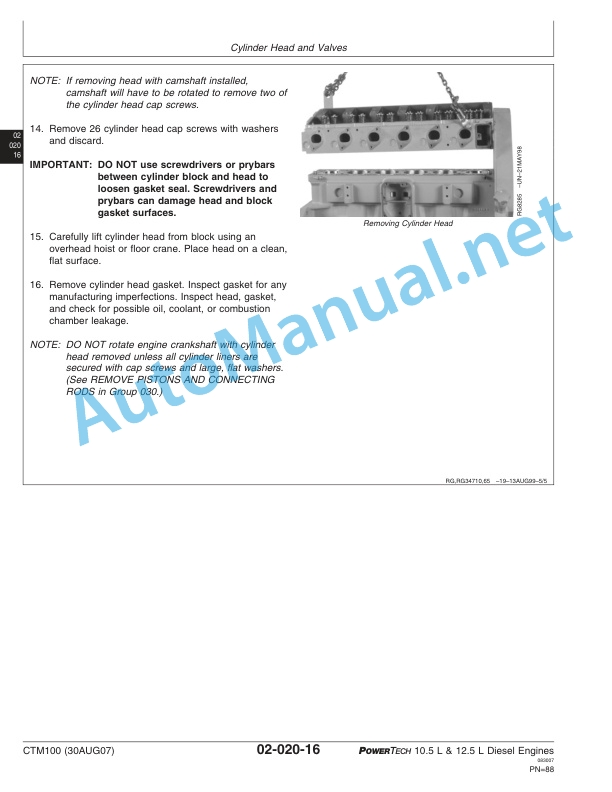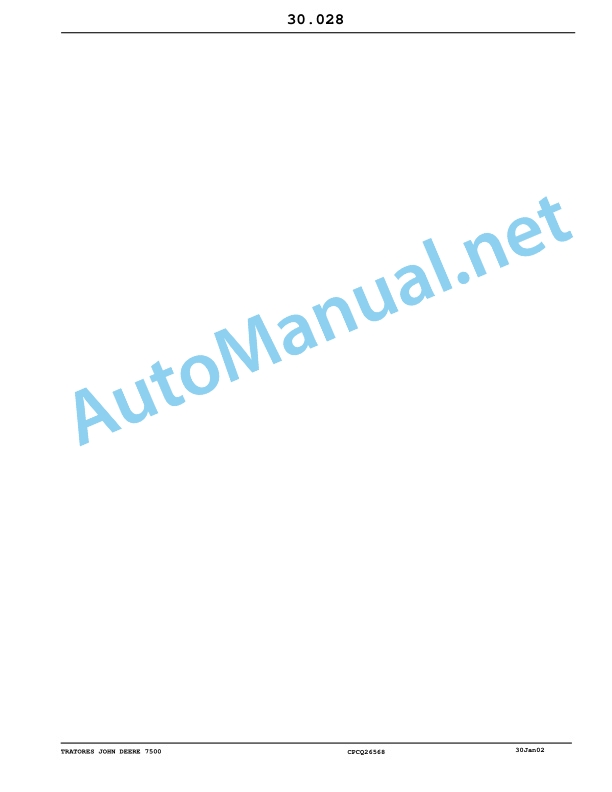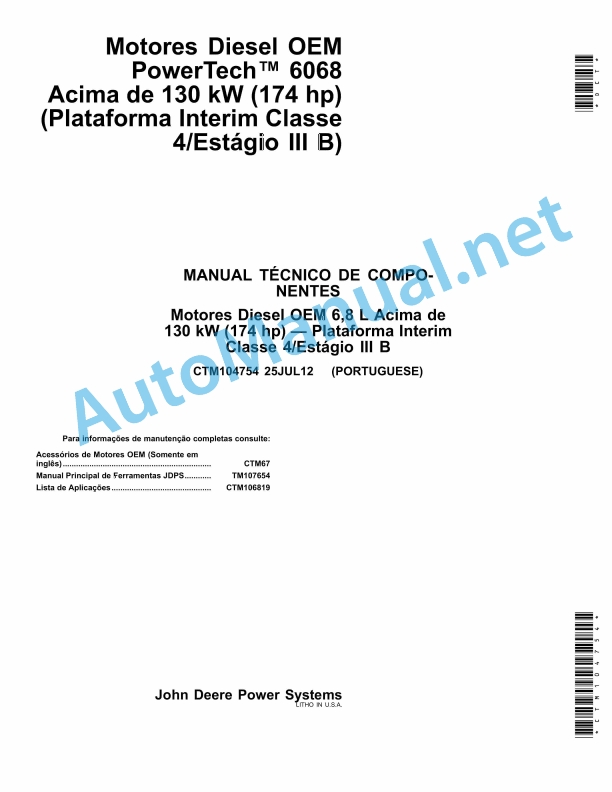Claas Jaguar 900-830 (493) Forage Harvesters Operator Manual ES
$50.00
- Model: Jaguar 900-830 (493) Forage Harvesters
- Type Of Manual: Operator Manual
- Language: ES
- Format: PDF(s)
- Size: 47.0 MB
File List:
00 0293 905 2.pdf
00 0294 371 4.pdf
00 0294 628 4.pdf
00 0295 292 0.pdf
00 0295 778 1.pdf
00 0293 905 2.pdf:
1. Introduction
1.1 General instructions
1.1.1 Using the instructions
1.1.2 Validity of instructions
1.1.3 Technical data
1.1.4 Road traffic
1.1.5 Note regarding electronic engine management
1.1.6 Information regarding the metal detector
1.1.7 Information regarding the stone detector
1.2 Identification plates and identification numbers
1.2.1 Spare parts and technical issues
1.2.2 Machine identification plate
1.2.3 Chopping unit identification plate
1.2.4 Mercedes-Benz OM 502 LA engine identification plate
1.2.5 Mercedes-Benz OM 460 LA engine identification plate
1.2.6 Drive shaft identification plate
2 Overall view of the machine
2.1 JAGUAR 900 -830 Profistar / Speedstar
2.1.1 General view of the machine front and left
2.1.2 General view of the machine behind and right
2.1.3 Summary of working sets
3 Security measures
3.1 General instructions
3.1.1 Safety at work
3.1.2 Use according to the destination
3.1.3 Prescriptions for safety and accident prevention
3.1.4 Safety rules and accident prevention rules Mincers
3.1.5 Before start-up, general instructions
3.1.6 Additional weights
3.1.7 Carry additional passengers
3.1.8 General driving
3.1.9 Forage chopper driving
3.1.10 Driving on inclined terrain
3.1.11 Getting off the machine
3.1.12 Front implements and trailer
3.1.13 Forage chopper chopper device
3.1.14 Air conditioning installation
3.1.15 Adjustment and maintenance work
3.1.16 Pressure accumulator
3.1.17 Antifreeze
3.1.18 First aid measures
3.1.19 Shims
3.1.20 Fire extinguisher
3.1.21 Battery separator switch
3.1.22 Risk of accident due to hydraulic fluid
3.1.23 Air pressure brake system inspection indication
3.1.24 Load and tie down the machine
3.2 Safety instructions
3.2.1 Warning and danger signs
3.3 Warning symbols
3.3.1 General instructions regarding warning symbols
3.3.2 Driver’s platform
3.3.3 Power
3.3.4 Machine components
3.3.5 Hydraulic installation
3.3.6 Engine
3.3.7 Download
4 Technical data
4.1 JAGUAR 900 / 890 / 870 / 850 / 830 Speedstar – TYPE 493
4.1.1 General instructions
4.1.2 Measurements
4.1.3 Weights
4.1.4 Driver’s platform
4.1.5 Electrical installation
4.1.6 Power
4.1.7 Undercarriage
4.1.8 Engine
4.1.9 Chop
4.1.10 Download
4.1.11 Central lubrication system
4.2 JAGUAR 900 / 890 / 870 / 850 / 830 Profistar – TYPE 493
4.2.1 General instructions
4.2.2 Measurements
4.2.3 Weights
4.2.4 Driver’s platform
4.2.5 Electrical installation
4.2.6 Power
4.2.7 Undercarriage
4.2.8 Engine
4.2.9 Chop
4.2.10 Download
4.2.11 Central lubrication system
5 Before first start-up
5.1 General instructions
5.1.1 Checklist for first start-up
5.1.2 Load and tie down the machine
5.2 Driver’s platform
5.2.1 Install high beam lights
5.2.2 High beam adjustment
5.2.3 Assemble work lights
5.2.4 Mount exterior mirror
5.2.5 Mount boot mirror (additional equipment)
5.2.6 Mount rotating flashing lights
5.2.7 Connect side window window washer equipment.
5.2.8 Install the fan/air conditioning fuse
5.3 Power
5.3.1 Remove the security screw
5.4 Machine components
5.4.1 Move away the cover plate located on the roof of the machine
5.4.2 Installing the trailer coupling (additional equipment)
5.5 Download
5.5.1 Modify the transport discharge elbow to the working position
5.6 Central lubrication system
5.6.1 Fill the central lubrication lubricant tank
6 Before each start-up
6.1 General instructions
6.1.1 Checklist for daily commissioning
6.2 Driver’s platform
6.2.1 Adjust boot mirror (additional equipment)
6.3 Undercarriage
6.3.1 Steering axle overview
6.3.2 Adjust the steering axle (000 769 250 0) track width
6.4 Machine components
6.4.1 Additional weights
6.4.2 Additional equipment from third-party suppliers
6.4.3 Silage additives
7 Overview of control elements
7.1 Driver’s platform
7.1.1 General view of the driver’s platform
7.1.2 Control desk
7.1.3 Monitors overview
7.1.4 General view of cabin roof
7.1.5 Central informant
7.1.6 Multifunctional handle
7.1.7 Gear lever
7.1.8 Adapt the position of the steering bar
7.1.9 Multifunctional switch
7.1.10 Mechanically damped driver’s seat (optional equipment)
7.1.11 Air suspension driver’s seat (optional equipment)
7.1.12 Automatic air conditioning system
7.1.13 Connect automatic air conditioning system
7.1.14 Adjust cabin temperature automatically
7.1.15 Adjust the cabin temperature manually
7.1.16 Adjust the air flow of the air conditioning system
7.1.17 Remove humidity from the cabin window
7.1.18 Show outside temperature
7.1.19 Change temperature indication to ˚Fahrenheit
7.1.20 Open the cabin roof
7.1.21 Close the cabin roof
7.1.22 Front window washer unit tank
7.1.23 Side window washer equipment tank
7.1.24 Driver Platform Plugs
7.1.25 Driver’s platform control elements
7.1.26 Access ladder
7.1.27 Open central electrical system
7.1.28 Close central electrical system
7.1.29 Central electrical system
7.1.30 Gear lever adjust driving resistance
7.2 Undercarriage
7.2.1 CLAAS 4-Trac System (optional equipment)
7.3 Machine components
7.3.1 Tool box
7.3.2 Work lights and driving lighting
7.3.3 Plug, 12 V
7.4 Engine
7.4.1 Ignition contact
7.4.2 Diesel engine speed
7.4.3 Connect the diesel engine
7.4.4 Disconnect the diesel engine
7.5 Brake system
7.5.1 Foot brake
7.5.2 Parking brake
8 Assemble/remove front implement and trailer
8.1 Front implement
8.1.1 Adjust the hydraulic installation of the machine to the head
8.1.2 Connect the central lubrication system tote front implement
8.2 Trailer
8.2.1 Uncoupling the trailer
8.2.2 Hitching the trailer
8.2.3 Hitching the trailer with pressurized air brake (additional equipment)
8.2.4 Uncoupling trailer with pressurized air brake (additional equipment)
9 Driving and transporting
9.1 General instructions
9.1.1 Prepare for road traffic
9.1.2 Prepare field circulation
9.1.3 Steer the machine
9.1.4 Parking the machine
9.1.5 Maneuver the machine
9.1.6 Running characteristics
9.1.7 Towing the machine
9.2 Driver’s platform
9.2.1 Adjusting the driver’s seat with mechanical damping (optional equipment)
9.2.2 Adjust driver’s seat with air suspension (optional equipment)
9.2.3 Shift gear
9.3 Running gear
9.3.1 Connect CLAAS 4-Trac system (optional equipment)
9.3.2 Disconnect CLAAS 4-Trac system (optional equipment)
9.4 Hydraulic system
9.4.1 Anti-vibration
9.4.2 Learn the anti-vibration system
9.4.3 Connect the anti-vibration
9.5 Engine
9.5.1 Regulation of diesel engine revolutions when driving on roads (electro-hydraulic)
9.5.2 Regulation of diesel engine revolutions in operational service (electro-hydraulic)
9.6 Brake system
9.6.1 Check brake pressure switch
9.6.2 Connect the parking brake
9.6.3 Disengage the parking brake
9.6.4 Brake the machine with the multifunction lever
9.6.5 Braking the machine with the foot brake
9.6.6 Pressurized air brake system (additional equipment) antifreeze pump
9.6.7 Pressurized air brake system (additional equipment) connect antifreeze pump
9.6.8 Pressurized air brake system (additional equipment) disconnect antifreeze pump
10 Setting in operational mode
10.1 General warnings
10.2 Power
10.2.1 Assemble the bottom plate
10.3 Chop
10.3.1 Chopping blades
10.3.2 Bedknife
10.3.3 Semi-blades (grass)
10.3.4 Mounting knife holder protection (additional equipment)
10.3.5 Reduce the number of chopper blades
10.3.6 Assemble the micro-friction system for the chopping blades (additional equipment)
10.3.7 Chopper bottom (optional equipment)
10.3.8 Manually presetting the chopping length
10.3.9 Adjust the chopping depth
10.4 Corn cracker
10.4.1 Decommissioning of corn-cracker (optional equipment)
10.4.2 Mount forage tank (optional equipment)
10.4.3 Mount corn-cracker (optional equipment)
11 Management of CIS
11.1 General instructions
11.1.1 Functions and indications
11.1.2 Before first start-up
11.2 Driver’s platform
11.2.1 Overview – status displays A
11.2.2 Overview – monitor area B
11.2.3 Overview – key area C
11.2.4 Calling functions/operating data
11.2.5 Modify values
11.2.6 Indicate and set the time
11.2.7 Indicate the total sum of work hours (CIS with on-board reporter)
11.2.8 Enter/reset the daily sum of working hours (CIS with on-board reporter)
11.2.9 Indicate operating hours
11.2.10 Indicate/reset daily area (CIS with on-board informant)
11.2.11 Indicate surface performance (CIS with on-board reporter)
11.2.12 Indicate the total area (CIS with on-board reporter)
11.2.13 Upcoming maintenance interval / indicate elapsed time (CIS with on-board informant)
11.2.14 Confirm the maintenance carried out (CIS with on-board reporter)
11.2.15 Set pulses/100 m
11.2.16 Set pulses/100 m per calibration run
11.2.17 Setting pulses/100 m by direct entry
11.2.18 Adjust the unit
11.2.19 Memorize the working position (CIS with on-board indicator)
11.2.20 Setting the working width (CIS with on-board indicator)
11.2.21 Adjusting the front implement partition (CIS with on-board information)
11.2.22 Adjust the partial width of the front implement (CIS with on-board indicator)
11.2.23 Learning the gear lever
11.2.24 Adjust the driving strategy
11.3 Power
11.3.1 Adjust the sensitivity of the metal detector
11.3.2 Check the pressure of the lifting hydraulic cylinder during support pressure regulation
11.3.3 Check current head height / cutting height preselection
11.3.4 Learn Contour end stops
11.3.5 Check the potentiometer for the head height
11.3.6 Adjust the potentiometer for the head height
11.3.7 Feed run stops
11.4 Running gear
11.4.1 Learn Autopilot
11.5 Parts mounted on the machine
11.5.1 Adjust the dosage of silage additives (from the machine number…)
11.6 Engine
11.6.1 Indicate engine load
11.6.2 Indicate the engine revolutions
11.6.3 Program the working revolutions regime
11.6.4 Fuel consumption indicator (additional equipment)
11.7 Chop
11.7.1 Adjust the chopping length
11.7.2 Adjust the number of chopper blades
11.7.3 Automatic sharpening and bedknife system
11.7.4 Define the number of sharpening cycles
11.7.5 Sharpening reminder function
11.7.6 Setting the time interval until the next sharpening
11.7.7 Check the time until the next sharpening
11.7.8 Connect the automatic sharpening system
11.7.9 Check the automatic sharpening system
11.7.10 Reset total sharpening cycles
11.7.11 Adjust the distance of the bed knife
11.7.12 Connect the automatic bedknife system
11.7.13 Monitor the automatic bedknife system
11.7.14 Set the residual state of the knives to their base value
11.7.15 Place the bedknife in the basic setting
11.7.16 Check the sensors of the automatic sharpening system and the counterblade
11.8 Corn cracker
11.8.1 Show distance between corn-cracker rollers (optional equipment)
11.8.2 Program the distance between the corn-cracker rollers (optional equipment)
11.9 Download
11.9.1 Learn the discharge elbow end stops
12 Operational service
12.1 General warnings
12.2 Driver’s platform
12.2.1 Cutting height control
12.2.2 Save cutting height
12.2.3 Memorize the support pressure
12.2.4 Connect cutting height control
12.2.5 Disconnect cutting height control
12.3 Power
12.3.1 Connect the power supply unit
12.3.2 Metal detector
12.3.3 Connecting the stone detector (additional equipment)
12.3.4 Disconnecting the stone detector (additional equipment)
12.3.5 Travel direction reversal system
12.3.6 Connect the direction reversal system
12.4 Running gear
12.4.1 CLAAS autopilot (additional equipment)
12.4.2 Connecting CLAAS autopilot (additional equipment)
12.4.3 Disconnecting CLAAS autopilot (additional equipment)
12.4.4 Adjust CLAAS autopilot center offset (additional equipment)
12.4.5 Adjust the laser pilot (additional equipment)
12.5 Machine components
12.5.1 Silage additive equipment
12.5.2 Connect the silage additive equipment
12.5.3 Disconnect the silage additive equipment
12.5.4 Silage additive tank
12.5.5 Silage additive equipment dosing nozzle
12.5.6 Select the dosing nozzle of the silage additives equipment
12.5.7 CLAAS ACTISILER silage additive equipment (additional equipment) overview of controls
12.5.8 Connecting CLAAS ACTISILER silage additive equipment (additional equipment)
12.5.9 Operating CLAAS ACTISILER silage additive equipment (additional equipment)
12.5.10 Adjust the calibration value of the CLAAS ACTISILER silage additive equipment (additional equipment)
12.5.11 Disconnecting the CLAAS ACTISILER silage additive equipment (additional equipment)
12.5.12 Fill the equipment with CLAAS ACTISILER silage additives (additional equipment)
12.5.13 Emptying CLAAS ACTISILER silage additive equipment (additional equipment)
12.6 Engine
12.6.1 Refuel the machine
12.7 Chop
12.7.1 Connect the chopper unit
12.7.2 Disconnect the chopper unit
12.7.3 Sharpen the chopper blades
12.7.4 Manually adjust the sharpening stone
12.7.5 Sharpening stone special tool
12.8 Corn cracker
12.8.1 Corn-cracker (optional equipment)
12.8.2 Electrically adjust the corn-cracker distance (optional equipment)
12.8.3 Mechanically adjust the corn-cracker distance (optional equipment)
12.9 Download
12.9.1 Download Accelerator
12.9.2 Discharge elbow
12.9.3 Raise the discharge elbow
12.9.4 Turn the discharge elbow
12.9.5 Lower the discharge elbow
12.9.6 Connect the automatic discharge elbow turning system (additional equipment)
12.9.7 Memorize the rotation position of the automatic discharge elbow rotation system (additional equipment)
13 Failures and solutions
13.1 General warnings
13.2 General instructions
13.2.1 Hydraulic system
13.2.2 Electrical installation
13.2.3 Air conditioning installation
13.2.4 Protection devices
13.2.5 Spare parts
13.2.6 Imbalance
13.2.7 Welding work on the chopper
13.2.8 Putting the machine out of service
13.2.9 Raise the machine on blocks
13.3 Driver’s platform
13.3.1 Automatic air conditioning system fault code table
13.3.2 Failures and solutions of the air conditioning installation
13.3.3 CIS alarm types
13.3.4 CIS fault code table
13.4 Running gear
13.4.1 CLAAS Autopilot fault and solution
13.4.2 Putting the shift lever interlock hydraulic cylinder out of service
13.5 Power outputs / drives
13.5.1 Failure in the investment process
13.6 Machine components
13.6.1 CLAAS ACTISILER faults and solutions
13.7 Engine
13.7.1 Cooling water temperature indication lights up
13.7.2 Diesel engine failure
13.8 Corn cracker
13.8.1 Manually adjusting the corn-cracker (optional equipment) with electrical distance regulation
13.9 Central lubrication system
13.9.1 Faults and solutions of the central lubrication system
14 Maintenance
14.1 General warnings
14.2 General instructions
14.2.1 Clean engine compartment and danger areas
14.2.2 Straps
14.2.3 Drives
14.2.4 Screws
14.2.5 Lubrication
14.2.6 Brakes
14.2.7 Wheels / tires
14.2.8 Hydraulic system
14.2.9 Electrical installation
14.2.10 Air conditioning installation
14.2.11 Coolant liquid
14.2.12 Protective devices
14.2.13 Spare parts
14.2.14 Imbalance
14.2.15 Putting the machine out of service
14.2.16 Raise the machine on blocks
14.2.17 Recommendations for the conservation of the forage harvester during the winter
14.3 Maintenance table
14.3.1 Maintenance intervals
14.4 Lubricant table
14.4.1 Lubricant
14.5 Driver’s platform
14.5.1 Clean/change the cabin air filter
14.5.2 Clean cab roof assemblies
14.5.3 Clean the air conditioning system condenser
14.5.4 Check the refrigerant level of the air conditioning system
14.5.5 Putting the air conditioning into service
14.5.6 Check the fire extinguisher
14.6 Electrical installation
14.6.1 Check the battery acid level
14.7 Power
14.7.1 Folding the power supply unit
14.7.2 Disassemble the power supply unit
14.7.3 Assembling the power supply unit
14.7.4 Adjusting the transport roller under the scraper
14.7.5 Adjusting the feed roller brake
14.7.6 Adjust the feed roller springs
14.7.7 Check the oil level of the upper gear rollers
14.7.8 Drain the oil from the upper gear rollers
14.7.9 Fill the oil in the upper gear rollers
14.7.10 Check the oil level of the gearbox supply unit
14.7.11 Drain the oil from the gearbox supply unit
14.7.12 Fill the oil in the gearbox supply unit
14.8 Drives
14.8.1 Release the chopping unit belt
14.8.2 Remove the belt from the chopper device
14.8.3 Install the chopper belt
14.8.4 Adjust the chopper unit belt
14.8.5 Remove the fan drive belt
14.8.6 Install the fan drive belt
14.8.7 Adjusting the fan drive belt
14.8.8 Remove the corn-cracker belt (optional equipment)
14.8.9 Assembling the corn-cracker belt (optional equipment)
14.8.10 Adjust the corn-cracker strap (optional equipment)
14.8.11 Remove the head drive belt
14.8.12 Install the head drive belt
14.8.13 Remove the belt from the hydraulic motor power unit
14.8.14 Assemble the hydraulic motor power supply unit belt
14.8.15 Adjust the belt of the hydraulic motor power unit
14.9 Running gear
14.9.1 Check the tightening torque of the wheel nuts
14.9.2 Clean the gearbox, around the drive axle
14.9.3 Check the oil level of the gearbox drive shaft
14.9.4 Drain the oil from the gearbox drive shaft
14.9.5 Fill gearbox drive shaft oil
14.9.6 Check the reducer oil level
14.9.7 Drain the oil from the reducer
14.9.8 Fill the reducer oil
14.9.9 Check the oil level of the drive steering axle differential gear (optional equipment)
14.9.10 Drain the oil from the drive steering axle differential gear (optional equipment)
14.9.11 Fill the drive steering axle differential gear oil (optional equipment)
14.9.12 Check the oil level of the drive axle reducer (optional equipment)
14.9.13 Drain the oil from the drive shaft reducer (optional equipment)
14.9.14 Fill the drive shaft reducer oil (optional equipment)
14.9.15 Check the oil level of the drive gear of the driven steering axle (optional equipment)
14.9.16 Evacuate the oil from the drive gear of the drive steering shaft (optional equipment)
14.9.17 Fill the drive gear oil of the drive steering shaft (optional equipment)
14.10 Machine components
14.10.1 Side cover
14.10.2 Rinse silage additive equipment
14.10.3 Clean the silage additive equipment nozzle
14.10.4 Clean the equipment filter for silage additives
14.10.5 Prepare silage additive equipment for wintering
14.10.6 Sweeping CLAAS ACTISILER silage additive equipment (additional equipment)
14.10.7 Setup of CLAAS ACTISILER silage additive equipment (additional equipment)
14.10.8 Pressurized air cleaning system
14.10.9 Check the pressure air cleaning system drain valve
14.10.10 Check the pressurized air cleaning system tank
14.10.11 Check the pressure regulator of the pressurized air cleaning system
14.10.12 Check the safety valve of the pressurized air cleaning system
14.11 Hydraulic system
14.11.1 Unload the pressure accumulator
14.11.2 Check the oil level in the hydraulic oil tank
14.11.3 Drain the oil from the hydraulic oil tank
14.11.4 Fill oil in the hydraulic tank
14.11.5 Change the hydraulic oil tank return filter
14.11.6 Evacuate the oil from the hydraulic motor
14.11.7 Change the hydraulic pump oil filter
14.11.8 Clean the surroundings of the hydraulic pump and hydraulic motor
14.12 Engine
14.12.1 Mercedes-Benz OM 502 LA engine summary
14.12.2 Mercedes-Benz OM 460 LA engine summary
14.12.3 General view of the refrigeration unit
14.12.4 Clean the diesel engine environment
14.12.5 Check the diesel engine oil level
14.12.6 Change diesel engine oil
14.12.7 Change the diesel engine oil filter
14.12.8 Fill diesel engine oil
14.12.9 Change the diesel engine purge filter
14.12.10 Check the timing gear oil level
14.12.11 Evacuate the oil from the distribution gear
14.12.12 Fill the timing gear oil
14.12.13 Check the fan gear oil level
14.12.14 Evacuate the oil from the fan gear
14.12.15 Fill the fan gear oil
14.12.16 Evacuate fuel from the fuel tank
14.12.17 Clean the fuel pre-filter filter
14.12.18 Change the fuel filter
14.12.19 Change the fuel prefilter
14.12.20 Bleed the fuel system
14.12.21 Drain the coolant from the water radiator
14.12.22 Check the coolant level of the water radiator
14.12.23 Fill the coolant in the water radiator
14.12.24 Identify the type of cooling agent
14.12.25 Mixing ratio of cooling agent
14.12.26 Replacing the cooling agent
14.12.27 Clean the refrigerant unit
14.12.28 Clean the air filter intake screen
14.12.29 Retighten the air intake pipe clamps
14.12.30 Clean/replace the diesel engine air filter
14.12.31 Change the safety cartridge of the diesel engine air filter
14.13 Chop
14.13.1 Fix the chopper blade cylinder
14.13.2 Adjust the chopper blades
14.13.3 Replacing the chopper blade
14.13.4 Retighten the chopper blade screws
14.13.5 Replacing the bed knife
14.14 Corn cracker
14.14.1 Check the distance of the corn-cracker (optional equipment)
14.14.2 Adjust the corn-cracker distance (optional equipment)
14.14.3 Bleeding the corn-cracker hydraulics (optional equipment)
14.14.4 Clean the corn-cracker (optional equipment)
14.14.5 Check the corn-cracker rollers (optional equipment)
14.14.6 Manually lubricate the corn-cracker (optional equipment)
14.15 Download
14.15.1 Clean the discharge elbow
14.15.2 Clean the discharge compartment
14.15.3 Replacing the accelerator launcher blade
14.15.4 Readjust the throttle paddle wheel
14.15.5 Discharge elbow wear plates
14.15.6 Adjust the discharge elbow fuse
14.16 Brake system
14.16.1 Clean the brake area
14.16.2 Check/fill brake fluid
14.16.3 Filling the antifreeze pump reservoir of the pressurized air brake system (additional equipment)
14.16.4 Check the pressure air brake system drain valve (additional equipment)
14.17 Central lubrication system
14.17.1 Central lubrication system
14.17.2 Central lubrication system pressure switch
14.17.3 Fill the central lubrication system tank
14.17.4 Connect the central lubrication system by hand
14.17.5 Manually lubricate central lubrication
15 Greasing scheme
15.1 Grease points
15.1.1 General warnings
15.1.2 Lubricants
15.1.3 Greasing intervals
15.1.4 Grease points – 10 h left
15.1.5 Greasing points – 10 h right.
15.1.6 Grease points – 50 h left
15.1.7 Grease points – 50 h right.
15.1.8 Grease points – 100 h left
15.1.9 Grease points – 100 h right.
15.1.10 Grease points – 250 h left
15.1.11 Grease points – 500 h left
15.1.12 Grease points – 500 h right.
Alphabetical index
00 0294 371 4.pdf:
JAGUAR 900 – 830
Regarding this instruction manual
General data
Manual validity
Management of CIS
General data
Functions and indications
Before first start-up
Driver’s cabin/platform
Overview – Status indicators A (up to machine number..
Overview – Screen area B (up to machine number…)
Overviewtatus displays A (from machine number…)
Overview – Screen area B (from machine number…)
Overview – key area C
Call functions/operation data
Modify values
Indicate and set the time
Indicate the total sum of work hours (CIS with on-board reporter)
Enter / reset the daily sum of working hours (CIS with on-board reporter)
Indicate operating hours
Indicate/reset daily area (CIS with on-board informant)
Indicate surface performance (CIS with on-board reporter)
Indicate the total area (CIS with on-board indicator)
Upcoming maintenance interval / indicate elapsed time (CIS with on-board indicator)
Confirm the maintenance carried out (CIS with on-board reporter)
Set pulses/100 m
Set pulses/100 m per calibration run.
Set pulses/100 m by direct entry
Adjust the unit
Memorize the working position (CIS with on-board information)
Adjust working width (CIS with on-bocator)
Adjusting the front implement partition (CIS with on-board informn)
Adjust partial width of front implement (CIS with on-board indicator)
Learning the gear lever
Adjust driving strategy
Power set
Check the pressure of the lifting hydraulic cylinder during the support pressure regulation
Control current head height / cutting height preselection
Program the Contour end stops
Check the potentiometer for the head height
Adjust the potentiometer for the head height
Feeding run stops
Learn Autopilot
Attached parts, machine housing
Adjust the dosage of silage additives (from the machine number…)
Indicate engine load
Indicate the engine revolutions
Program the working revolution regime
Fuel consumption indicator (additional equipment)
Automatic sharpening and bedknife system
Define the number of sharpening cycles
Sharpening reminder function
Set the time interval until the next sharpening
Check the time until the next sharpening
Connect the automatic sharpening system
Control the automatic sharpening system
Reset total sharpening cycles
Adjust bedknife distance
Connect the automatic bedknife system
Monitor the automatic bedknife system
Set the residual state of the blades to their base value
Adjust the base position of the bedknife
Check the sensors of the automatic sharpening system and the bedknife
Corn Cracker
Show distance between corn-cracker rollers (optional equipment)
Program the distance between the corn-cracker rollers (optional equipment)
Grain tank unloading
Learn Discharge Elbow End Stops
Incident and solution
CIS alarm types
CIS fault code table
00 0294 628 4.pdf:
1. Introduction
1.1 General instructions
1.1.1 Using the instructions
1.1.2 Validity of instructions
2 Security measures
2.1 Observe
2.1.1 Especially important
2.1.2 Warning and danger signs
3 Supply set
3.1 Quantimeter with COMMUNICATOR
3.1.1 Retrofit kit 000 140 982 1 / 009 100 870 4
4 Assembly
4.1 Set up COMMUNICATOR performance measurement
4.1.1 Transform the central electrical system
4.1.2 Install the cable set
4.1.3 Installing the COMMUNICATOR control element
4.1.4 Disassemble the power supply casing
4.1.5 Mount the angle sensor
4.1.6 Assemble the power housing
4.1.7 Connect the angle sensor
4.1.8 Prepare and perform a functional test
5 Before first start-up
5.1 General instructions
5.1.1 Checklist for first start-up
6 Operation CLAAS COMMUNICATOR
6.1 General instructions
6.1.1 CLAAS COMMUNICATOR
6.2 Control element and display
6.2.1 Control element
6.2.2 Chopper menu with progress screen
6.2.3 Chopper menu with work screen
6.3 Menu structure
6.3.1 Select menu
6.3.2 Chopper menu summary
6.3.3 Advance screen menu / work screen
6.3.4 Orders menu
6.3.5 Counterbalanced menu
6.3.6 Calibration menu
6.3.7 Counter menu
6.3.8 Service menu summary
6.4 Calibration
6.4.1 Determine the calibration measurement and adjust it
6.4.2 Adjust the reaction threshold
6.4.3 Zero crack learning
Alphabetical index
00 0295 292 0.pdf:
1. Introduction
1.1 General instructions
1.1.1 Using the instructions
1.1.2 Validity of instructions
2 Security measures
2.1 Observe
2.1.1 Especially important
2.1.2 Warning and danger signs
3 Supply set
3.1 Quantimeter with CLAAS CEBIS MOBILE
3.1.1 Retrofit kit 009 101 592 7 / 009 101 592 8
4 Assembly
4.1 Set up the CLAAS CEBIS MOBILE performance measurement
4.1.1 Transform the central electrical system
4.1.2 Install the cable set
4.1.3 Installing the CEBIS MOBILE control element
4.1.4 Disassemble the power supply casing
4.1.5 Mount the angle sensor
4.1.6 Assemble the power housing
4.1.7 Connect the angle sensor
4.2 Assemble yield mapping (supplementary equipment) CEBIS MOBILE
4.2.1 Mount the GPS antenna (supplementary equipment)
5 Before first start-up
5.1 General instructions
5.1.1 Checklist for first start-up
6 Before each start-up
6.1 CLAAS CEBIS MOBILE
6.1.1 Insert the chip card
7 Operation CLAAS CEBIS MOBILE
7.1 General instructions
7.1.1 CLAAS CEBIS MOBILE
7.2 Control element and display
7.2.1 Control element
7.2.2 Chopper menu with progress screen
7.2.3 Chopper menu with work screen
7.2.4 Orders menu
7.3 Menu structure
7.3.1 Select menu
7.3.2 Chopper menu summary
7.3.3 Menu progress screen / work screen
7.3.4 Counterbalanced menu
7.3.5 Calibration menu
7.3.6 Counter menu
7.3.7 Order menu summary
7.3.8 Orders menu
7.3.9 GPS Menu
7.3.10 Settings menu
7.4 Calibration
7.4.1 Determine the calibration measurement and adjust it
7.4.2 Adjust the reaction threshold
7.4.3 Zero crack learning
Alphabetical index
00 0295 778 1.pdf:
1. Introduction
1.1 General instructions
1.1.1 Using the instructions
1.1.2 Validity of instructions
1.1.3 Technical data
1.2 Identification plates and identification numbers
1.2.1 Spare parts and technical issues
1.2.2 Identification plate
2 Security measures
2.1 General instructions
2.1.1 Especially important
2.1.2 Use according to the destination
2.2 Safety instructions
2.2.1 Warning and danger signs
2.3 Warning symbols
2.3.1 General information on warning symbols
2.3.2 Adapter
3 Supply set
3.1 LEXION head adapter
3.1.1 Rear mounting kit
4 Assembly
4.1 Prepare the assembly
4.1.1 Putting the machine out of service
4.1.2 Check the supply set
4.2 Assemble the machine assembly
4.2.1 Assemble the hydraulic system (only JAGUAR type 492/493)
4.2.2 Assemble the electrical installation (only JAGUAR type 492/493)
4.2.3 Assemble the installation (only JAGUAR type 494)
4.2.4 Shortening the power take-off adapter (only JAGUAR type 493/494)
4.2.5 Pre-assemble the multiple coupling
4.2.6 Assemble the reel circumferential speed cable set (cutting mechanism only, type 492/493 only)
4.2.7 Prepare and perform a functional test
5 Technical data
5.1 JAGUAR – LEXION head adapter – TYPE 492 / 493 / 494
5.1.1 Measurements
5.1.2 Weights
5.1.3 Allowed heads
6 Before first start-up
6.1 General instructions
6.1.1 General warning instructions Before initial start-up
6.1.2 Checklist for first start-up
7 Before each start-up
7.1 General instructions
7.1.1 General warning instructions Before each start-up
7.1.2 Commissioning checklist
8 Mount/dismount the front implement
8.1 General instructions
8.1.1 General warning instructions Mounting/dismounting the head
8.2 Mount the adapter
8.2.1 Connect the cable set (only JAGUAR type 494)
8.2.2 Removing the quick coupler (only JAGU
John Deere Repair Technical Manual PDF
John Deere DF Series 150 and 250 Transmissions (ANALOG) Component Technical Manual CTM147 05JUN98
John Deere Repair Technical Manual PDF
John Deere Repair Technical Manual PDF
John Deere Repair Technical Manual PDF
John Deere Application List Component Technical Manual CTM106819 24AUG20
John Deere Repair Technical Manual PDF
John Deere Repair Technical Manual PDF
John Deere Parts Catalog PDF
John Deere Tractors 7500 Parts Catalog CPCQ26568 30 Jan 02 Portuguese
John Deere Repair Technical Manual PDF
John Deere Repair Technical Manual PDF

